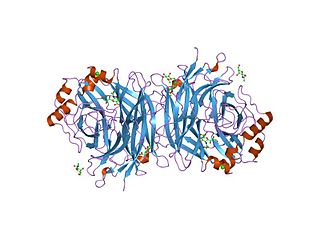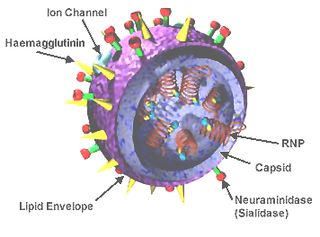
Paramyxoviridae is a family of viruses in the order Mononegavirales. Vertebrates serve as natural hosts; no known plants serve as vectors. Currently, 49 species are placed in this family, divided among seven genera. Diseases associated with this negative-sense, single-stranded RNA virus family include measles, mumps, and respiratory tract infections.

Influenza hemagglutinin (HA) or haemagglutinin[p] is a homotrimeric glycoprotein found on the surface of influenza viruses and integral to its infectivity.

The Orthomyxoviruses are a family of RNA viruses that includes seven genera: Influenza virus A, Influenza virus B, Influenza virus C, Influenza virus D, Isavirus, Thogotovirus, and Quaranjavirus. The first four genera contain viruses that cause influenza in vertebrates, including birds, humans, and other mammals. Isaviruses infect salmon; the thogotoviruses are arboviruses, infecting vertebrates and invertebrates, such as ticks and mosquitoes.
Antigenic drift is a mechanism for variation in viruses that involves the accumulation of mutations within the genes that code for antibody-binding sites. This results in a new strain of virus particles which cannot be inhibited as effectively by the antibodies that were originally targeted against previous strains, making it easier for the virus to spread throughout a partially immune population. Antigenic drift occurs in both influenza A and influenza B viruses.

Mumps rubulavirus is the causative agent of mumps, and is considered a viral infection. Characteristics include swelling of the parotid glands, salivary glands and other epithelial tissues. Symptoms of mumps are fatigue, body aches, headache, loss of appetite, low grade fever, swelling of the salivary glands. If not caught earlier, can also result in muscle pain, deafness, meningitis, swelling of testicles or ovaries, and death. Most people who contract mumps show symptoms of the virus, however there are few who show no or very few symptoms. Natural infection is currently restricted to humans and the virus is transmitted by direct contact, droplet spread, or contaminated objects.

Neuraminidase enzymes are glycoside hydrolase enzymes that cleave (cut) the glycosidic linkages of neuraminic acids. Neuraminidase enzymes are a large family, found in a range of organisms. The best-known neuraminidase is the viral neuraminidase, a drug target for the prevention of the spread of influenza infection. The viral neuraminidases are frequently used as antigenic determinants found on the surface of the influenza virus. Some variants of the influenza neuraminidase confer more virulence to the virus than others. Other homologues are found in mammalian cells, which have a range of functions. At least four mammalian sialidase homologues have been described in the human genome.
Influenza B virus is the only species in the genus Betainfluenzavirus in the virus family Orthomyxoviridae.

Influenza C virus is the species in the genus Influenzavirus C in the virus family Orthomyxoviridae, which like other influenza viruses, causes influenza.

H5N1 genetic structure is the molecular structure of the H5N1 virus's RNA.

Influenza research involves investigating molecular virology, pathogenesis, host immune responses, genomics, and epidemiology regarding influenza. The main goal of research is to develop influenza countermeasures such as vaccines, therapies and diagnostic tools.
Sendai virus (SeV), previously also known as murine parainfluenza virus type 1 or hemagglutinating virus of Japan (HVJ), is a negative sense, single-stranded RNA virus of the family Paramyxoviridae, a group of viruses featuring, notably, the genera Morbillivirus and Rubulavirus. SeV is a member of genus Respirovirus, members of which primarily infect mammals.
The genus Avulavirus is one of seven genera in the family Paramyxoviridae and contains viruses that used to be classified in the genus Rubulavirus. In contrast to rubulaviruses, avulaviruses infect birds and translate protein V from an edited RNA transcript. Avulaviruses have a hemagglutinin-neuraminidase attachment protein and do not produce a non-structural protein C. The most important and best characterized avulavirus is Newcastle disease virus, a variant of avian paramyxovirus 1. Avulaviruses can be separated into distinct serotypes using hemagglutination assay and neuraminidase assay. All avulaviruses hemagglutinate chicken RBCs except for avian paramyxovirus 5 which does not hemagglutinate RBCs from any species. Avian paramyxovirus 6 is unique to the presence of the SH gene between the F and HN genes. Avian paramyxovirus 11 has the longest genome among the APMVs.

Viral neuraminidase is a type of neuraminidase found on the surface of influenza viruses that enables the virus to be released from the host cell. Neuraminidases are enzymes that cleave sialic acid groups from glycoproteins and are required for influenza virus replication.
Measles hemagglutinin is a hemagglutinin produced by measles virus.
Parainfluenza hemagglutinin-neuraminidase is a type of hemagglutinin-neuraminidase produced by parainfluenza.

In molecular biology, glycoside hydrolase family 83 is a family of glycoside hydrolases.

George Keble Hirst, M.D. was an American virologist and science administrator who was among the first to study the molecular biology and genetics of animal viruses, especially influenza virus. He directed the Public Health Research Institute in New York City (1956–1981), and was also the founding editor-in-chief of Virology, the first English-language journal to focus on viruses. He is particularly known for inventing the hemagglutination assay, a simple method for quantifying viruses, and adapting it into the hemagglutination inhibition assay, which measures virus-specific antibodies in serum. He was the first to discover that viruses can contain enzymes, and the first to propose that virus genomes can consist of discontinuous segments. The New York Times described him as "a pioneer in molecular virology."

Influenza D virus is a species in the virus genus Influenzavirus D in the family Orthomyxoviridae, that causes influenza.










